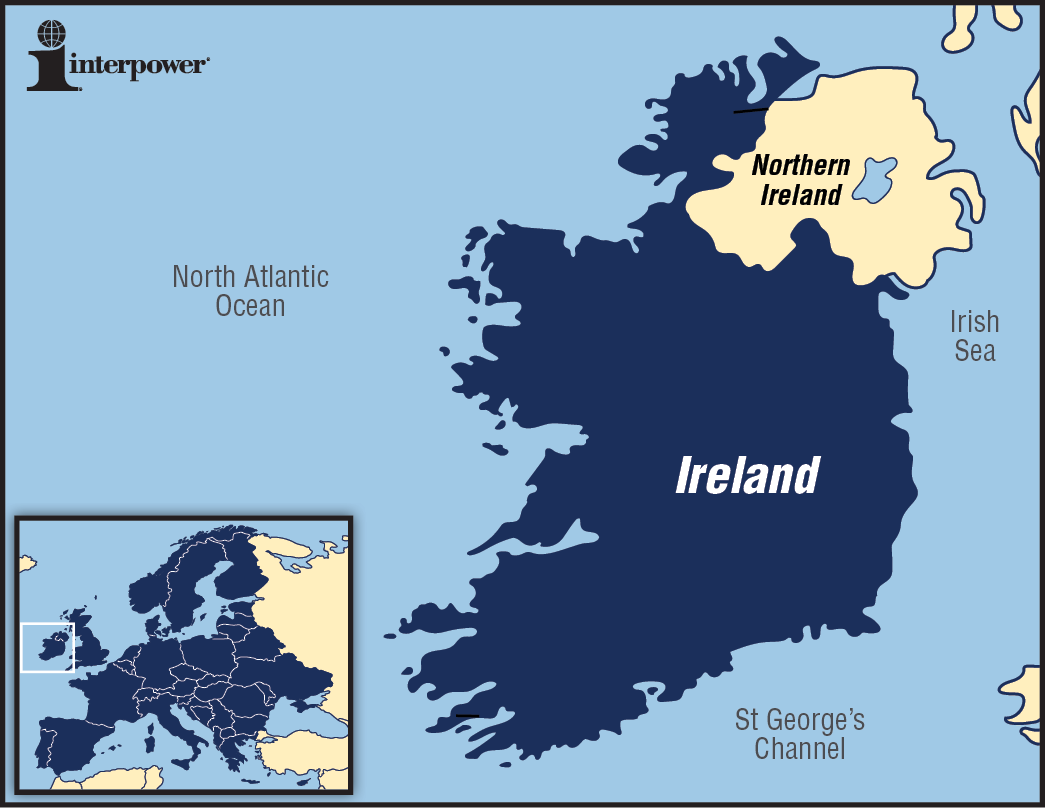Exporting to Ireland

| IRELAND | |
|---|---|
| Actual population* | Population world ranking |
| 4,832,765 | 123 |
| Actual GDP (PPP)* | GDP world ranking |
| $190.4 billion | 59 |
| Actual GDP (per capita)* | GDP (per capita) world ranking |
| $41,300 | 25 |
*See the end of this blog for definitions
An open and growing economy helps to create a pro-business climate in the country of Ireland. A member of the European Union, Ireland is also a key part of the international market.
Due to its location, Ireland can also be a gateway to Europe and other regions. For small to medium size businesses that are looking to export for the first time in the EU, Ireland can be a good, potential market. Choosing a local partner or setting up a local sales office are among suggested market entry strategies. It is recommended to visit Ireland in person to help establish a positive business relationship. Within the country, one resource for assistance in starting a business is the Irish Citizens Information Board.
For a company to increase its prospects for success, it’s important to learn what the Irish business customs are. Learn what is acceptable when greeting others along with the accepted business attire. Friendship and mutual trust are key elements to developing a good business association, along with courtesy and punctuality. Schedule business meetings in advance and promptly reply to sales requests. Have business cards readily available for distribution.
There are a variety of resources which can give more details regarding market entry strategies, doing business in Ireland, business customs, and import/export requirements. These include the United States Commercial Service and the United Kingdom Trade and Investment.
Located in Northern Europe, Ireland joined the European Union in 1973. The EU is a Customs Union which consists of member countries who have formed a single region for customs purposes. Goods that have been imported legally can circulate throughout the EU with no further customs checks. To learn more about the customs regulations, among the sources to consult are the European Commission Export Helpdesk and European Commission Taxation and Customs Union. Conducting due diligence in accordance with all of the regulations is essential.
Some products may require safety testing and certification for this market. While not all products are required to have a CE mark, others do require one. When affixing the CE mark to a product, a manufacturer affirms that the product meets the necessary requirements and can be sold throughout the EU.
There are also EU regulations that need to be followed, so it’s important to know what is required in Ireland. Among them are:
- REACH is the European regulation for Registration, Evaluation, Authorization, and Restriction of Chemicals. The European Commission works closely with ECHA (European Chemicals Agency) in the implementation of this regulation.
- RoHS stands for Restriction of Hazardous Substances. It restricts the use of certain hazardous materials found in electrical and electronic products.
- WEEE stands for Waste from Electrical and Electronic Equipment. WEEE requires the treatment, recovery, and recycling of electric and electronic equipment.
The two official languages in Ireland are Irish and English. While English is the language usually used in business, it is advised to define any terms that have the potential to be misinterpreted, in order to ensure that all information is understood correctly.
In Ireland, the voltage used is 230V at 50Hz. The most frequently specified plug pattern is the United Kingdom plug.
Sources:
www.export.gov/ireland
www.gov.uk
www.citizensinformation.ie/en
Sources for European Union:
www.ec.europa.eu
www.echa.europa.eu
www.rohsguide.com
www.exporthelp.europa.eu
www.europa.eu
www.export.gov/europeanunion
*Source: www.cia.gov/library/publications/the-world-factbook/index.html
Country comparison—Population: Population compares estimates from the US Bureau of Census based on statistics from population censuses, vital statistics, registration systems, or sample surveys pertaining to the recent past and on assumptions about future trends. (July 2014 est.)
Country comparison—GDP (Purchasing Power Parity): GDP (purchasing power parity [PPP]) compares the gross domestic product (GDP) or value of all final goods and services produced within a nation in a given year. A nation’s GDP at PPP exchange rates is the sum value of all goods and services produced in the country valued at prices prevailing in the United States. (2013 est.)
Country comparison—GDP – per capita (PPP): GDP – per capita (PPP) compares GDP on a purchasing parity basis divided by population as of 1 July for the same year. (2013 est.)






